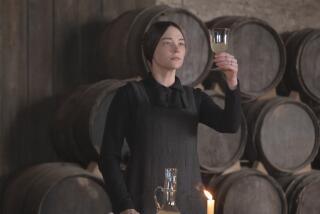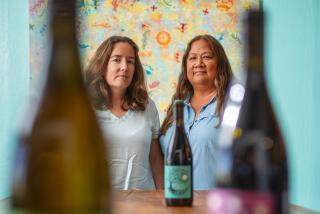Newcomers of Note : Two Champagne Houses Enter the Southern California Market to Acclaim
NOWHERE IN THE world is the aristocracy of the grape more specifically delineated than in the Champagne regions of France. There, as elsewhere, the best wine comes from the best grapes. One reason for tracking grape yield and quality so closely is the determination of the peasant-farmer growers to be economic shareholders in the wine profits of the aristocratic great houses that use their grapes. For years, to help insure a fair-share delineation of each vintage, vineyards have been classified on a 100% par scale, and growers have been paid on the yield based on that scale. A 95% vineyard will get 95% of the top price. A Champagne composed of grapes with cuvees solely from 100% vineyards can be called grand cr u ; those from 90% to 99% are entitled only to premier cru status. The 100%-classified communes that make up the crus of the Montagne de Reims in La Champagne are Ambonnay, Verzenay, Beaumont-sur-Vesle, Bouzy, Louvois, Mailly-Champagne, Puisieulx, Verzy and Sillery.
Important names, of course, but perhaps even more significant are two village communes in the Cote des Blancs--Avize and Cramant--noted by the Champagne trade association CIVC as “two of the most glorious jewels in the Champagne crown,” growing Chardonnay almost exclusively. Newer upscale classifications also include, as the third element of a quality triumvirate, Le Mesnil-sur-Oger.
All of this is preface to the introduction of two relative newcomers to the Southern California French Champagne market, both of which have vineyard pedigrees of grand cru status. One is Bricout, which comes from Avize; the other is A. Salon Blanc de Blancs 1979 Brut, from Le Mesnil. The latter has prompted some wine writers to declare Salon le Mesnil the world’s greatest Champagne, and it indeed already has a loyal following able and willing to pay the $100-per-bottle price.
Our salute, however, is for the more affordable, yet equally impressive grand cru and premier cru status wines of Bricout, from the 100% vineyards of Avize. I was there in June, walking among the vines, touring the cellars and tasting the wines. I met the brilliant chef de caves , Christophe Bernard, and dined with him in the ancient Chateau d’Avize from which the first splendid Champagne was released in 1820.
Bricout Champagnes are currently being imported by A. Racke U.S.A., owner of the Buena Vista Winery in Sonoma, where I first encountered this premium bubbly a couple of years ago. The name may be new to many connoisseurs of fine Champagnes, but the aristocracy of these imports’ vineyard/wine status is undisputed, and they are fine values, handsome to behold, fabulous to sip and cherish.
Bricout Carte Noire Brut Reserve NV ($20): Refreshing, of fine breed and bouquet, grapes from top cru vineyards of Avize for Chardonnay, Verzenay for the Pinot Noir.
Bricout 1983 Carte or Brut ($25): Within the stunning crystal bottle, a cuvee of 60% Chardonnay, 40% Pinot Noir explains the truly lovely refinement of this long, rich, four-years-on-the-yeast Champagne.
Bricout 1983 Elegance de Bricout Cuvee Speciale ($50): Note the fine bead; the rich complexity from 55% Chardonnay, 45% Pinot Noir; the toasty, regal taste, reflecting its grand cru status, the bottle itself a replica of that first Champagne from Bricout in 1820, 168 years ago. An extraordinary experience in fine Champagne.
More to Read
Eat your way across L.A.
Get our weekly Tasting Notes newsletter for reviews, news and more.
You may occasionally receive promotional content from the Los Angeles Times.










